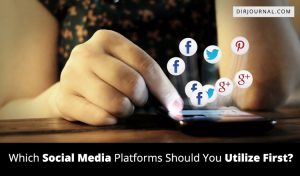

When starting a new brand, it’s hard to know which social media platforms will offer you the greatest return on your time, money and resources. Factors like conversion rate, lead generation, and of course, ROI, will inform your choices, but you also need to account for your audience. Which groups of people are you targeting? And, where do they spend the bulk of their time? Are you catering more to male or female users? These factors will ultimately determine which networks should occupy your attention. Initially you’ll want to keep your options open, experimenting and testing out many different platforms. After extensive analysis, you’ll be able to narrow your options down to a few that are most effective. To get started, here are 4 of the most prevalent social media platforms used by nearly every business in existence today.
Facebook is still the most widely used social media channel ever. The site has 1.71 billion monthly active users, and 1.13 billion that are active each day. Not only are there continents full of users on Facebook everyday, but they tend to be logged in for long periods of time. The average user will spend nearly 30 minutes a day scrolling through posts, updating statuses, and liking pages. For businesses, this can be huge. Where else can you command an audience’s attention for half an hour a day?
While Facebook can be utilized with a wide range of demographics in mind, it has become the #1 news source among all Millennials. 57% of them monitor Facebook at least once a day for their news and information. For this reason, businesses need to treat Facebook posts like breaking news stories, by enlightening users through attention-getting copy and highlighting current events related to their products and experiences.


It’s also a platform that’s slightly more favored by female users, which isn’t uncommon across social media.
Facebook contains many native targeting methods for identifying and targeting influencers as well, especially when used as a means of generating backlinks for your brand.
Facebook offers business pages that can serve as a storefront for your website. You can post statuses like with a normal Facebook profile, and they will appear on the news feed of your followers.
Instead of adding people as friends, like you would on a regular Facebook profile, they follow your page as “fans.” You can also post all kinds of contact information, images, and video content.
The younger cousin of Facebook sees 120 million unique monthly visitors. Although that number pales in comparison to Facebook’s billions in viewership every month, Twitter is arguably a lot more influential in our society. It allows celebrities and brands a space to interact with fans and grow their following. It even has it’s own language (hashtags #).
eMarketer found that Twitter users are primarily located outside of the United States, with the top three countries being Japan, Brazil, and Mexico (India expected to join the top three by 2019).
Twitter’s character limit on tweets is conducive to international advertising, as it allow brands to exercise brevity and avoid language confusion. While Facebook permits users to input paragraphs upon paragraphs into the status window, Twitter limits all content to 140 characters.
What was a once a basic photo filter tool used among friends, is now a ubiquitous social media app with more active users than Twitter. Instagram sees 400 million users each month, making it one of the fastest growing networks over the past 4 years. Like Twitter, over 80% of users live outside of the United States.
For brands looking to enhance their international reach, consider focusing on Instagram from the start. The app allows you to include engaging text under each photo, intended to drive traffic to your site.
Probably not the first social media platform to come to mind, Pinterest is a powerful tool, especially when catering to a female demographic. Approximately 80% of the platform’s registered users are women, and they account for 94% of Pinterest’s user activity. This lands in stark contrast to the parody found among Facebook and Twitter users.
Try Others
Facebook, Twitter, Instagram, and Pinterest are just the jumping off point for your social media experimentation. Consider other platforms and digital marketing tools that sit well with your B2B and B2C marketing goals. For example, some great B2B networks to consider are LinkedIn, Meetup, VisualCV, or PartnerUp. Whichever you choose to utilize, be sure to narrowly focus your targeting by location, age, gender, and interests, to determine which platforms offer the best conversion rates for your brand.
Michael Peggs is the founder of Marccx Media, a digital marketing agency specializing in Search Engine Optimization (SEO) and Search Engine Marketing (SEM). Before Marcxx, Peggs worked at Google in business development, forming digital media and advertising partnerships in the United States and Asia. He is also a contributor to The Huffington Post, FastCompany and Business Insider as well as and podcaster, hosting the iTunes Top 10 New & Noteworthy Podcast You University.